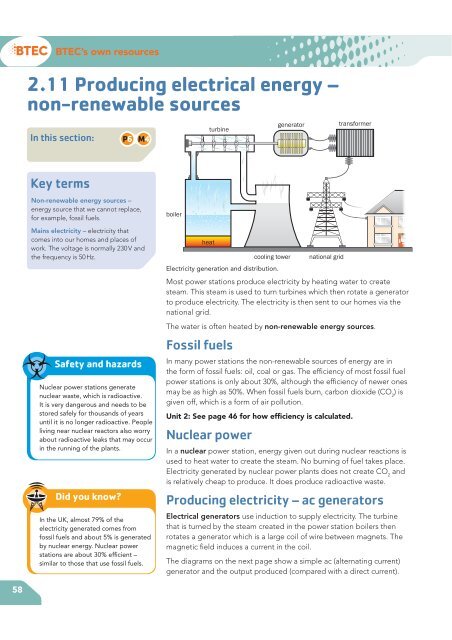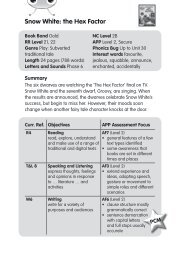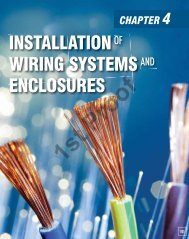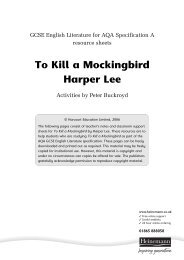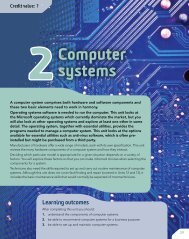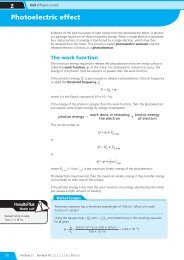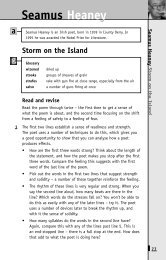Energy and our Universe - Pearson Schools
Energy and our Universe - Pearson Schools
Energy and our Universe - Pearson Schools
Create successful ePaper yourself
Turn your PDF publications into a flip-book with our unique Google optimized e-Paper software.
58<br />
BTEC’s own res<strong>our</strong>ces<br />
2.11 Producing electrical energy –<br />
non-renewable s<strong>our</strong>ces<br />
In this section:<br />
Key terms<br />
Non-renewable energy s<strong>our</strong>ces –<br />
energy s<strong>our</strong>ce that we cannot replace,<br />
for example, fossil fuels.<br />
Mains electricity – electricity that<br />
comes into <strong>our</strong> homes <strong>and</strong> places of<br />
work. The voltage is normally 230 V <strong>and</strong><br />
the frequency is 50 Hz.<br />
Did you know?<br />
P6 M4<br />
Safety <strong>and</strong> hazards<br />
Nuclear power stations generate<br />
nuclear waste, which is radioactive.<br />
It is very dangerous <strong>and</strong> needs to be<br />
stored safely for thous<strong>and</strong>s of years<br />
until it is no longer radioactive. People<br />
living near nuclear reactors also worry<br />
about radioactive leaks that may occur<br />
in the running of the plants.<br />
In the UK, almost 79% of the<br />
electricity generated comes from<br />
fossil fuels <strong>and</strong> about 5% is generated<br />
by nuclear energy. Nuclear power<br />
stations are about 30% efficient –<br />
similar to those that use fossil fuels.<br />
boiler<br />
heat<br />
turbine<br />
Electricity generation <strong>and</strong> distribution.<br />
generator<br />
cooling tower national grid<br />
transformer<br />
Most power stations produce electricity by heating water to create<br />
steam. This steam is used to turn turbines which then rotate a generator<br />
to produce electricity. The electricity is then sent to <strong>our</strong> homes via the<br />
national grid.<br />
The water is often heated by non-renewable energy s<strong>our</strong>ces.<br />
Fossil fuels<br />
In many power stations the non-renewable s<strong>our</strong>ces of energy are in<br />
the form of fossil fuels: oil, coal or gas. The efficiency of most fossil fuel<br />
power stations is only about 30%, although the efficiency of newer ones<br />
may be as high as 50%. When fossil fuels burn, carbon dioxide (CO 2 ) is<br />
given off, which is a form of air pollution.<br />
Unit 2: See page 46 for how efficiency is calculated.<br />
Nuclear power<br />
In a nuclear power station, energy given out during nuclear reactions is<br />
used to heat water to create the steam. No burning of fuel takes place.<br />
Electricity generated by nuclear power plants does not create CO 2 <strong>and</strong><br />
is relatively cheap to produce. It does produce radioactive waste.<br />
Producing electricity – ac generators<br />
Electrical generators use induction to supply electricity. The turbine<br />
that is turned by the steam created in the power station boilers then<br />
rotates a generator which is a large coil of wire between magnets. The<br />
magnetic field induces a current in the coil.<br />
The diagrams on the next page show a simple ac (alternating current)<br />
generator <strong>and</strong> the output produced (compared with a direct current).


